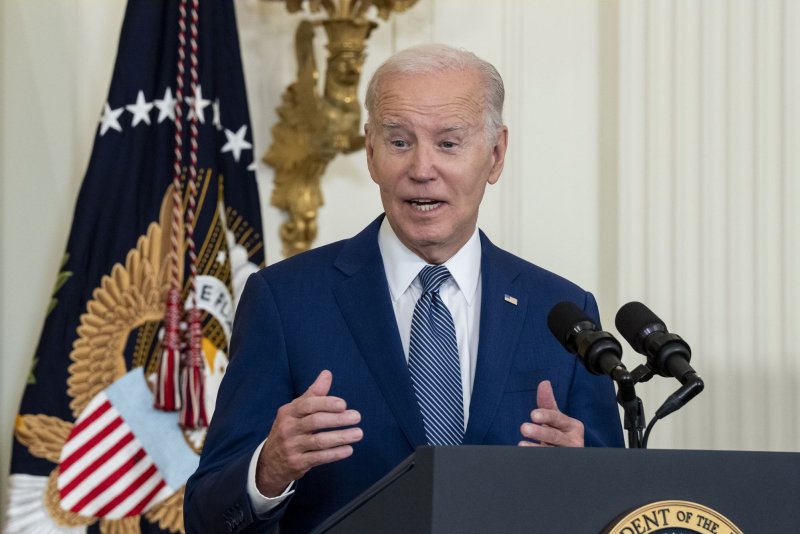1 of 3 | During the kick-off of a three-week "Investing in America" push by the White House, President Joe Biden announced Monday the allocation of $40 billion in federal funds to be distributed to states in an effort to expand high-speed Internet to more Americans, calling it the "biggest investment in high-speed Internet ever." Photo by Ken Cedeno/UPI |
License Photo
June 26 (UPI) -- President Joe Biden announced Monday the allocation of $40 billion in federal funds to be distributed to states in an effort to expand high-speed Internet to every nook of the country by 2030.
"It's the biggest investment in high-speed Internet ever, because for today's economy to work for everyone, Internet access is just as important as electricity was or water or other basic services," Biden announced.
"You know, what we're doing is, as I said, not unlike what Franklin Delano Roosevelt did when he brought electricity to nearly every American home and farm in our nation," the president added, referencing the 32nd U.S. president.
Monday's announcement kicked off a three-week "investing in America" push by the administration, in which officials will make numerous public appearances to tout the ongoing effect of Biden's legislative agenda, including massive infrastructure projects across the nation.
About 8.5 million homes and businesses nationwide do not have Internet access, the White House said.
During a White House event in the East Room marking the announcement Monday, U.S. Vice President Kamala Harris reiterated the importance of high-speed Internet access.
"Today, 24 million people in our country do not have access to high-speed Internet, either because they cannot afford the monthly cost of a plan or because they live in communities that have not yet been fully connected to fiber-optic networks," Harris said. "But let us agree: In the 21st century, in America, high-speed Internet is not a luxury; it is a necessity."
The newest funding will go to states with the most need as part of the Broadband Equity Access and Deployment Program -- a major provision of Biden's $1.2 trillion Bipartisan Infrastructure Law of 2021, in which each state could receive $100 million or more from the government to boost connectivity.
"To date, over 35,000 projects are either funded or already underway across the country thanks to the law," Biden said. "This includes hundreds of high-speed Internet projects in rural and Tribal communities."
"But it's not enough to have access. You need affordability in addition to access," Biden said.
"That's why we worked with Internet service providers to bring down prices for Americans struggling with Internet payments. It's called the Affordable Connectivity Program. It's helping 19 million families save around $30 a month on their Internet bills, and some save a lot more."
The $40 billion will be distributed to all 50 states and to areas where there is no service or where service is too slow.
"It includes rural communities like Appalachia," Biden said. "It includes Tribal lands from Alaska to the Dakotas, coastal towns from Hawaii to the Pacific Northwest. It also includes suburban communities, even cities, neighborhoods, and -- where there's a lot of people -- you think it's automatic, but some still have to use dial-up connections to get online."
The White House said it plans to release the dollar amounts that each qualifying state could receive, based on specific needs.
To get the funds, states will need to submit blueprints to the Commerce Department by December, explaining how the money will be spent.
State and local governments would next submit their plans to the National Telecommunications and Information Administration, which would begin distributing the funds next spring.
States won't get all the money right away, with the government allocating only 20% of the infrastructure funds during this first round of payouts as part of an 18-month rollout that will continue through the end of 2025.
The administration said it will allocate the funds using updated broadband coverage maps as more than 1 million new coverage locations have come online nationwide in the past year.
Earlier this month, the government announced $930 million in new infrastructure projects that aim to "close the digital divide for everyone in America" by expanding middle mile high-speed Internet infrastructure across 35 states and Puerto Rico.
The White House also launched a program to help more people, including families in the poorest sectors of the country, afford Internet access.
The Online For All campaign will feature grass-roots organizations and corporate entities working with the Department of Education to help families pay monthly Internet service costs as "research indicates that approximately half of the remaining qualified Americans are not aware of the program," the White House said previously.
In February, Vice President Kamala Harris called high-speed Internet a "basic necessity" in announcing a $175 million fund in helping secure Internet access at the nation's 61 Historically Black Colleges and Universities.
Altogether, the Biden administration expects to spend more than $90 billion to expand affordable Internet access, with another $25 billion provided through the American Rescue Plan to boost connectivity in many economically challenged regions.















